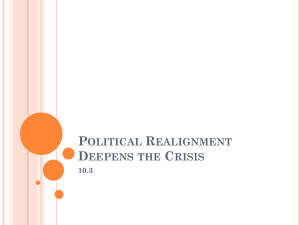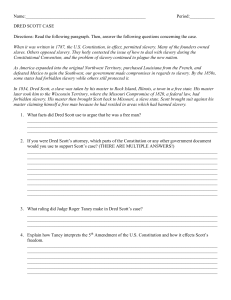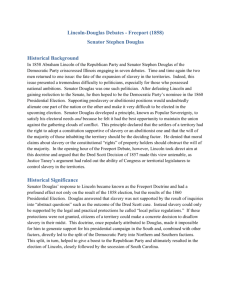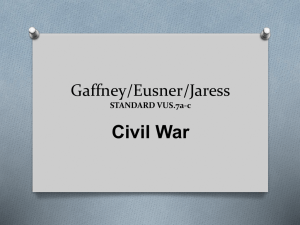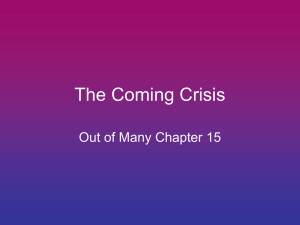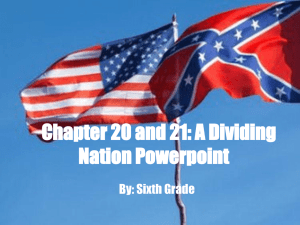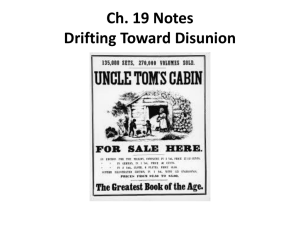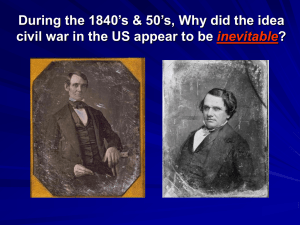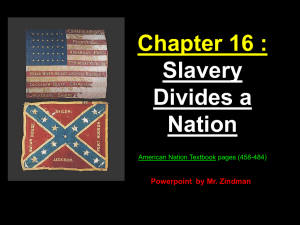And Black People Were at the Heart of It (1846-1861)- Part 2
advertisement
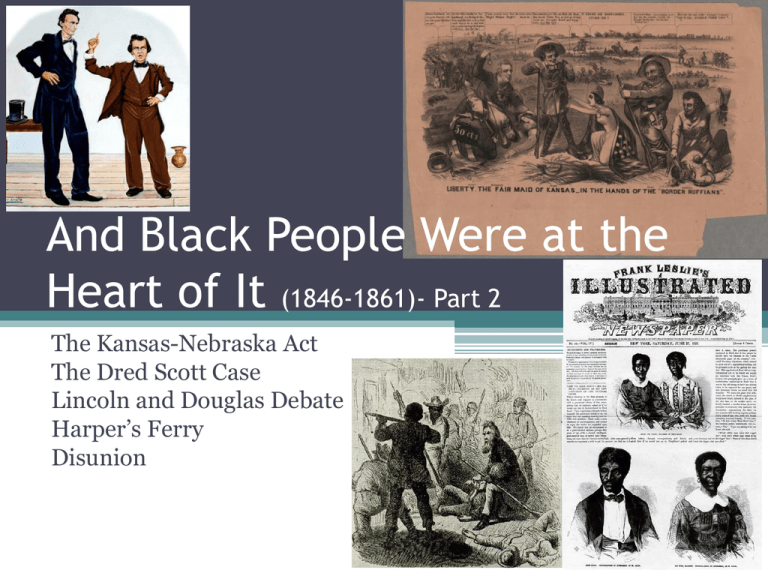
And Black People Were at the Heart of It (1846-1861)- Part 2 The Kansas-Nebraska Act The Dred Scott Case Lincoln and Douglas Debate Harper’s Ferry Disunion Kansas-Nebraska Act Douglas’s proposal for “popular sovereignty” in the KansasNebraska territories angered Northerners since it went against the Missouri Compromise line (36º30’N). This act opened territories to slavery that had been closed to it for 30yrs, and also led to the division of the North and South and violence over Kansas. “Border ruffians” from Missouri invaded Kansas, attacked antislavery settlements and voted illegally in elections. The New England Emigrant Aid Society sent people packing “Beecher’s Bibles” to help in Kansas. The papers labeled the area “Bleeding Kansas” and 200 people died in the ensuing violence. The Kansas-Nebraska Act Preston Brooks Attacks Charles Sumner Congress also became violent over the idea of popular sovereignty in the Kansas and Nebraska territories when Sen. Charles Sumner (MA) accused Sen. Andrew Butler (SC) of “keeping slavery as his lover.” Congressman Preston Brooks (SC) was Butler’s cousin, and he exacted revenge on Sumner by beating him with a ratan cane severely enough to cause Sumner to leave Congress for 4yrs with physical and emotion injuries. The 1856 election followed shortly after with Northern Democrat, James Buchanan against Republican John C. Freemont. Buchanan won the election, but Republicans gained strength and looked to the election of 1860. The Dred Scott Decision Dred Scott was a slave to a Missouri military doctor in the 1830’s. His owner brought him into the North (IL and MN) where Scott remained for 3yrs., marrying and having a child. 1846, Emerson- his owner- died and Scott and his wife, Harriet, filed for freedom suits. They argued that since they were brought to territories where slavery was illegal, that they were free. Scott lost his 1st case, won his 2nd, lost again on appeal to Missouri Supreme Court, appealed to a U.S. Circuit Court and lost, and finally appealed to the U.S. Supreme Court. Chief Justice Roger B. Taney presided over the case, and handed down a ruling that would influence the future of both slavery and Scott. Questions for the Court Two questions needed to be answered by Taney and the Supreme Court: 1) Could Scott, a black man, sue in a federal court? Taney ruled that black people could not sue in a federal since they were not citizens– essentially stating that black people had no rights. This was not an accurate remark since blacks had been treated as citizens in several states, even voting in 5 out of the 13 states at one point. 2) Was Scott free because he had been taken to a state and territory where slavery was prohibited. The court ruled against this and stated that slave owners property rights took precedence. They overturned the measures of Congress that prevented slave owners from bringing slaves into states without slavery as well. This was a major turning point for the slave discussion in the U.S. Reactions, White Northerners, Black Americans Whites were split over the decision– Southerners were delighted and Republicans horrified. African Americans were disgusted and spoke out at rallies and meetings against a government that denied them their rights. Although many white northerners were moved by the struggle of slaves, many were indifferent, fearful, or hostile to blacks and did not want them to migrate north. Most of the Old Northwest (IL, IN, IO) except for OH banned black settlement or disenfranchised blacks. Alexis de Tocqueville talked of the hypocrisy in Northern ideals when he stated, “The prejudice of race appears to be stronger in the states that have abolished slavery then in those where it still exists; and nowhere is it so intolerant as in those states where servitude has never been known.” The Lincoln-Douglas Debates The Illinois Senatorial race led to one of the most important debates of the time between Abraham Lincoln and Stephen Douglas. Their debates were centered on race and slavery. The Freeport Debate was the most famous. Lincoln challenged Douglas with the question of whether slavery could exist into any federal territory with the Dred Scott decision. Douglas’s response laid the groundwork for the fracturing of the Democratic party as well as the ability to resist slavery expansion. Douglas contended that if states did not enact slave codes to protect and control slave property, then slave owners would not settle in northern territories. Abraham Lincoln and Black People The Lincoln-Douglas debates generally turned to “mud slinging,” in which each candidate argued for who favored whites more and blacks less. Douglas was an advocate of white supremacy, but Lincoln did not differ much. Lincoln did not believe in racial equality and stated, “I do not understand that because I do not want a negro woman for a slave I must necessarily have her for a wife.” Lincoln did, however, believe that race should not deny someone the right to be a free laborer. Although Douglas won the Senatorial seat, Lincoln made a strong impression and Douglas angered the southerners and split the Democratic party. John Brown & Raid on Harpers Ferry John Brown was a radical abolitionist who had taken party in “Bleeding Kansas” He attempted to gain support for a mass uprising and in 1859 had amassed 17 followers (including 3 of his sons and 5 black men) to storm the federal arsenal at Harper’s Ferry, VA to secure weapons and then move south. His plan went awry when the 1st person they killed was a free black man. They then holed up in the arsenal and were surrounded and taken by local militia and U.S. Marines. 8 of Brown’s men (including 2 of his sons) were killed. Brown was charged with treason and hanged with 2 of his conspirators. Northerners mourned his loss as a martyr, and Southerners were horrified and angered by the Northern sympathy. After the trial, jurors barns were burned and livestock was poisoned. The Election of Abraham Lincoln The election of 1860 featured 4 candidates: 1) Stephen Douglas- Northern Democrat 2) John C. Breckenridge- Southern Democrat 3) John Bell- Constitutional Union (Former Whigs) 4) Abraham Lincoln- Republican Lincoln’s name was not featured on the southern ballots since the Republican party opposed the expansion of slavery. Many Northern blacks and abolitionists were also reluctant about supporting Lincoln and the Republican party due to the racism and contradictions they saw in Lincoln’s beliefs. Disunion When Lincoln won the election, the Southern states felt that they had lost their voice in politics and felt they had no other course but to secede. SC seceded on Dec. 20th, 1860 and by Feb. 1861, seven states had seceded (SC, MS, AL, FL, LA, GA, and TX) to form the Confederate States of America. Lincoln attempted to assure these states in his inaugural address that slavery would not be ended, but secession also would not be tolerated. A month after his address, Fort Sumter was surrounded and on April 12th, 1861, the 1st shots of the Civil War were fired. Four more states seceded (VA, TN, NC, and AK) and the Civil War had began. Conclusions • Tensions increased between the North and South as the government became more and more involved in the issue of slavery. • The view of blacks was very contradictory in the North where they did not like slavery, yet did not like blacks. • Lincoln’s election, along with the violence in Kansas, John Brown’s raid, and the Freeport Doctrine ultimately led to secession. • HW: Work on Ch.8-10 Essay (due Monday) and wrap up your final presentations (due Thursday)
